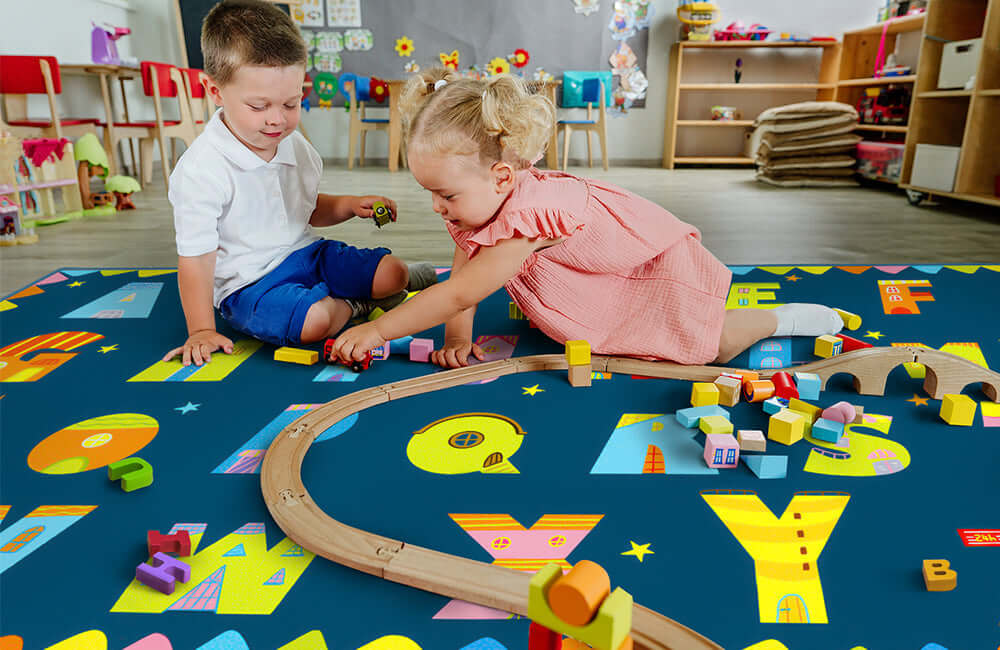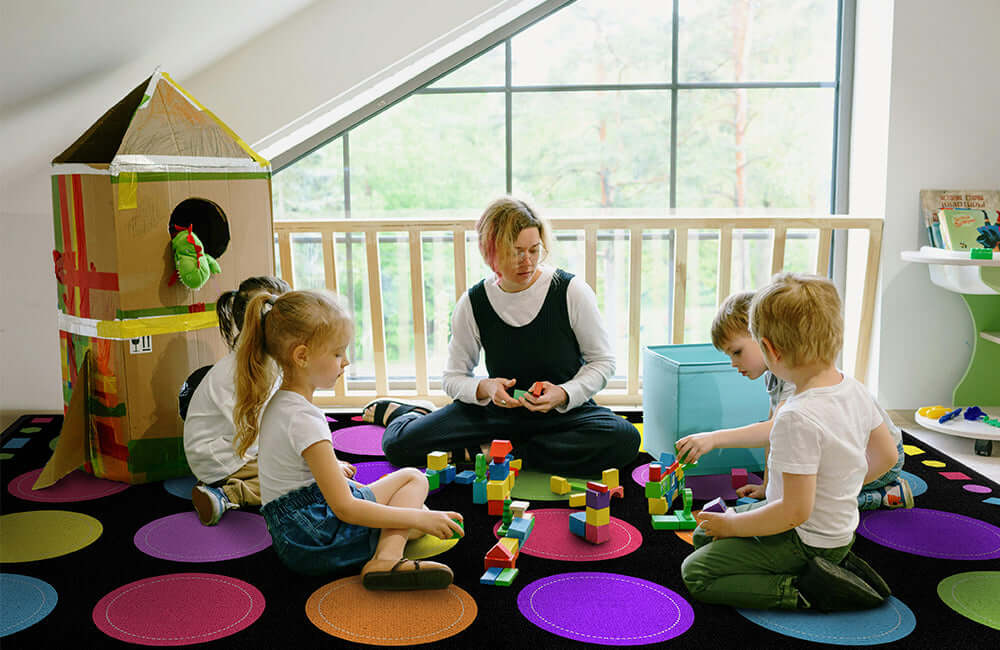In today's educational environments, where classroom square footage is increasingly precious, teachers face the challenge of creating functional, inviting spaces within tight constraints. Reading corners—those essential havens for literacy development and quiet engagement—often compete with instructional areas, centers, and technology stations for limited floor space. Yet their importance cannot be overstated: a well-designed reading nook signals to students that literacy is valued, provides crucial sensory boundaries in busy classrooms, and creates opportunities for both direct instruction and independent exploration.
At the heart of these compact literacy spaces often sits an unsung hero of classroom design: the small-format rug. More than just floor covering, these carefully selected textiles define reading territories, create sensory comfort, and transform otherwise institutional corners into inviting literacy environments—all while respecting the spatial limitations of today's classrooms. This article explores how thoughtfully chosen compact rugs can maximize the impact of even the smallest reading corners, creating spaces where young readers can flourish.
Benefits of Dedicated Reading Corner Rugs
Creating Defined Literacy Spaces
According to research from the International Literacy Association, clearly defined reading spaces signal the importance of literacy and create psychological boundaries that support focused engagement. Even in the smallest classrooms, a dedicated rug creates what literacy specialist Dr. Maya Santos calls a "literacy microenvironment"—a space with its own identity and purpose.
Supporting Body Positioning for Reading
Comfortable body positioning significantly impacts reading engagement. As explained in Wikipedia's article on reading education, physical comfort directly affects attention span during reading activities. Small rugs with appropriate cushioning provide:
- Softer seating options than institutional flooring
- Boundaries that help young bodies understand where to position themselves
- Tactile comfort that extends reading stamina
- Postural support when combined with pillows or floor seating
Acoustic Benefits
Often overlooked in reading corner design is the acoustic advantage provided by even compact rugs. Reading specialist Emma Chen notes that "small rugs absorb sound and create auditory boundaries that help students filter classroom noise during independent reading." This sensory management becomes particularly important in open-concept classrooms or spaces where multiple activities occur simultaneously.
Size Considerations for Small Spaces
Minimum Functional Dimensions
For reading corners to function effectively, rugs must accommodate both readers and books while respecting spatial constraints:
Individual Reading Spots
- Minimum 3' x 3' for a single primary reader
- Minimum 4' x 4' for 2-3 primary readers
- Allowance for book bins and display within reach
Small Group Instruction
- Minimum 4' x 6' for teacher plus 2-3 students
- Orientation that maximizes instructional sightlines
- Space for essential instructional materials
Proportional Planning
Classroom design experts from Educational Environment Quarterly recommend that reading corner rugs follow the "rule of thirds" for visual harmony:
- Rug should occupy approximately 1/3 of the designated reading area
- At least 1/3 of the rug should remain open for comfortable positioning
- Remaining space accommodates essential literacy materials and seating supports
Spatial Integration
Rather than viewing the reading corner rug as an isolated element, effective designs integrate it with surrounding features:
- Position against walls or in corners to maximize perceived space
- Utilize adjacent furniture boundaries to extend the defined area
- Create visual connection with nearby literacy displays and resources
Strategic Shapes for Space Maximization
Beyond Rectangles: Alternative Shapes
While rectangular rugs remain classroom standards, alternative shapes offer advantages in constrained spaces:
Semicircular Designs
- Fit naturally into corners, utilizing otherwise awkward spaces
- Create natural focus point for small group instruction
- Eliminate unused corners of traditional rectangular rugs
Hexagonal and Octagonal Options
- Provide more seating positions than comparably sized rectangles
- Create visual interest that defines the space more distinctly
- Offer multiple orientation possibilities within the same footprint
Modular Systems
- Carpet tiles or connectable rug sections adapt to irregular spaces
- Allow reconfiguration as classroom needs change
- Enable replacement of worn sections without full rug replacement
Orientation Strategies
The positioning of even small rugs significantly impacts their spatial efficiency:
- Diagonal placement can maximize usable floor area in square corners
- Alignment with traffic patterns reduces wear and extends usability
- Consideration of door swings and furniture access in placement decisions
Material Selection for Reading Areas
Durability Considerations
Reading corners experience concentrated, repeated use, requiring materials that withstand:
- Constant body movement during reading sessions
- Friction from shifting positions and cushions
- Regular cleaning requirements
- Potential for book-related spills and marker accidents
Sensory Properties
Material selection significantly impacts the sensory experience of reading spaces:
Pile Height
- Low pile (under ¼") supports stability for younger readers
- Medium pile (¼" to ½") enhances comfort while maintaining functionality
- High pile should generally be avoided in classroom contexts due to maintenance challenges
Texture Variation
- Subtle texture provides sensory feedback that helps define the space
- Overly rough textures can distract from reading engagement
- Extremely smooth surfaces may not provide adequate friction for comfortable positioning
Health and Safety Factors
According to School Health and Safety Guidelines, reading corner rug materials should prioritize:
- Non-toxic manufacturing processes and materials
- Low VOC emissions for indoor air quality
- Anti-microbial properties or treatments
- Non-slip backing or appropriate anchoring systems
Color and Pattern Psychology
Color Impact on Reading Environment
Color selection for reading corner rugs influences both the perception of space and reading behavior:
Space-Enhancing Colors
- Lighter tones create perception of expanded space
- Cool colors (blues, greens) visually recede, making areas seem larger
- Monochromatic schemes create cohesion in small spaces
Reading-Supportive Colors
- Blues and greens support focused attention
- Neutrals with minimal distraction allow books to remain visual focus
- Warm accents create inviting atmosphere without overwhelming
Pattern Considerations
Patterns on reading corner rugs serve both aesthetic and functional purposes:
Visual Interest vs. Distraction
- Subtle patterns hide inevitable stains and wear patterns
- Overly complex designs compete with reading materials
- Borders define space without creating visual busyness
Functional Patterns
- Simple seating spots help young readers position themselves
- Compass designs create natural meeting places for discussion
- Patterns that include indirect literacy elements (like simple word borders)
Budget-Friendly Solutions
Investment Prioritization
With limited classroom budgets, strategic investment in reading corner rugs requires consideration of:
- Long-term durability vs. initial cost
- Multi-functionality for various instructional purposes
- Replacement costs over anticipated classroom use
Creative Alternatives
For classrooms with severely constrained budgets:
- Carpet remnants with finished binding (often available at significant discounts)
- Washable fabric rugs that serve dual purposes
- Collaborative grants with other teachers for shared resources
- Parent/community donation programs for specific literacy environment needs
Maintenance Cost Factors
Total cost of ownership extends beyond purchase price:
- Cleaning requirements and associated supplies
- Expected lifespan under classroom conditions
- Replacement cycle planning
- Storage needs during deep cleaning periods
Arrangement Strategies
Layering Techniques
Even in small spaces, thoughtful layering creates dimension:
- Small textured rug atop existing classroom carpeting for sensory distinction
- Strategic overlap with adjacent instructional areas for space efficiency
- Seasonal or thematic top layers that refresh the space periodically
Integration with Other Elements
Reading corner rugs function as foundation elements that support:
- Low bookshelves that double as seating boundaries
- Vertical display spaces that extend the reading environment upward
- Lighting elements that define the space without requiring additional square footage
Flexible Configurations
Classroom design specialist Patricia Moore suggests that "even fixed reading corners benefit from planned reconfiguration options that refresh the space and adapt to changing instructional needs." Small rugs facilitate:
- Seasonal rotation of orientation and position
- Adjustment for varying group sizes throughout the year
- Integration with changing thematic units and literacy focuses
Maintenance in High-Traffic Areas
Daily Care Routines
Sustained functionality requires consistent maintenance:
- Regular vacuuming schedule (ideally daily in primary classrooms)
- Immediate spot treatment protocol for spills
- Student responsibility systems for basic care
- Weekly edge and corner adjustment to prevent tripping hazards
Deep Cleaning Considerations
According to Healthy Learning Environments Journal, reading corner rugs should receive:
- Monthly deep cleaning during the school year
- Vacation period removal for comprehensive cleaning
- Sanitization appropriate to age group and usage patterns
- Documentation of cleaning for health compliance
Extending Usable Life
Strategic practices significantly impact longevity:
- Rotation of position to distribute wear patterns
- Seasonal removal during units with high mess potential
- Protection during classroom parties or special events
- Proper vacation storage in climate-controlled environments
Conclusion
The humble reading corner rug, despite its small footprint, carries outsized importance in today's space-constrained classrooms. When selected with careful attention to size, shape, material, and design, these compact floor coverings transform institutional corners into literacy sanctuaries—defined spaces where young readers can engage deeply with text away from classroom bustle.
For educators navigating the challenges of creating effective learning environments within limited square footage, thoughtfully chosen compact rugs offer remarkable return on investment. They simultaneously define space, enhance comfort, improve acoustics, and signal the value of literacy—all while respecting the spatial realities of modern classrooms.
As you evaluate your own literacy environment, consider how a strategically selected small-format rug might enhance your reading corner, creating an inviting literacy microenvironment that supports your instructional goals despite space limitations. In the landscape of classroom design, these modest textiles truly exemplify the principle that small elements, thoughtfully chosen, can create environments of outsized impact.








Leave a comment
This site is protected by hCaptcha and the hCaptcha Privacy Policy and Terms of Service apply.